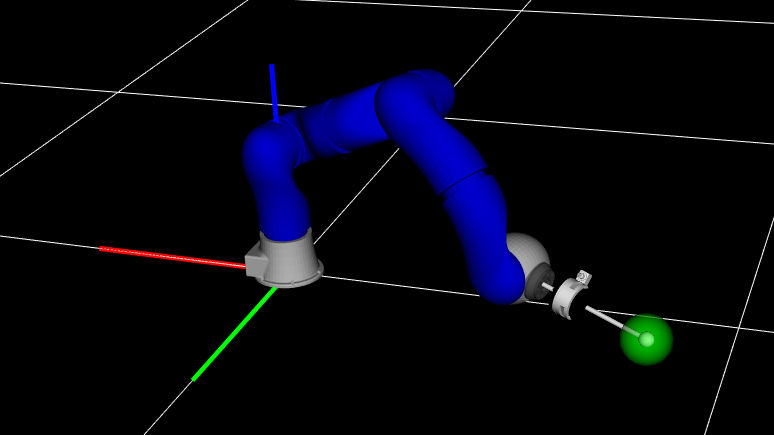 |
OpTaS
1.0.7
An optimization-based task specification library for trajectory optimization and model predictive control.
|
 |
OpTaS
1.0.7
An optimization-based task specification library for trajectory optimization and model predictive control.
|

OpTaS is an OPtimization-based TAsk Specification library for trajectory optimization and model predictive control.
In the past, OpTaS supported ROS from an internal module. This functionality, with additional updates, has now been moved to a dedicated repository: optas_ros.

In this example we implement an optimization-based IK problem. The problem computes an optimal joint configuration \(q^*\in\mathbb{R}^n\) given by
\[ q^* = \underset{q}{\text{arg}\min}~\|q - q_N\|^2\quad\text{subject to}\quad p(q) = p_g, q^-\leq q \leq q^+ \]
where
The example problem has a quadratic cost function with nonlinear constraints. We use the nominal configuration \(q_N\) as the initial seed for the problem.
The following example script showcases some of the main features of OpTaS: creating a robot model, building an optimization problem, passing the problem to a solver, computing an optimal solution, and visualizing the robot in a given configuration.
Run the example script example.py. Other examples, including dual-arm planning, Model Predictive Control, Trajectory Optimization, etc can be found in the [example/](example) directory.
The following operating systems and python versions are officially supported:
Note that OpTaS makes use of dataclasses that was introduced in Python 3.7, and so Python versions from 3.6 and lower are not supported on any operating system. Other operating systems or higher Python versions will likely work. If you experience problems, please submit an issue.
Make sure pip is up-to-date by running $ python -m pip install --upgrade pip.
Alternatively, you can also install OpTaS using:
$ python -m pip install 'optas @ git+https://github.com/cmower/optas.git'
$ git clone --recursive git@github.com:cmower/optas.git (if you do not want to build the documentation then the --recursive flag is not necessary)$ cd optas$ pip install .$ pip install .[example]$ pip install .[test]$ cd /path/to/optas/doc$ sudo apt install doxygen graphviz$ python gen_mainpage.py$ doxygenhtml/index.htmllatex/refman.pdf$ cd /path/to/optas$ pytest tests/test_builder.py$ pytest tests/test_examples.py$ pytest tests/test_models.py$ pytest tests/test_optas_utils.py$ pytest tests/test_optimization.py$ pytest tests/test_solver.py$ pytest tests/test_spatialmath.py$ pytest tests/test_sx_container.pyAttributeError error is thrown when you try to solve an unconstrained problem with the OSQP interface. A temporary workaround is to add a constraint, e.g. x >= -1e9 where x is a decision variable. See details on the issue here and pull request here.If you use OpTaS in your work, please consider including the following citation.
The preprint can be found on arXiv.
We welcome contributions from the community. If you come across any issues or inacuracies in the documentation, please submit an issue. If you would like to contribute any new features, please fork the repository, and submit a pull request.
This research received funding from the European Union’s Horizon 2020 research and innovation program under grant agreement No. 101016985 (FAROS). Further, this work was supported by core funding from the Wellcome/EPSRC [WT203148/Z/16/Z; NS/A000049/1]. T. Vercauteren is supported by a Medtronic / RAEng Research Chair [RCSRF1819\7\34], and C. Bergeles by an ERC Starting Grant [714562]. This work has received funding from the European Union’s Horizon 2020 research and innovation programme under grant agreement No 101017008, Enhancing Healthcare with Assistive Robotic Mobile Manipulation (HARMONY).
